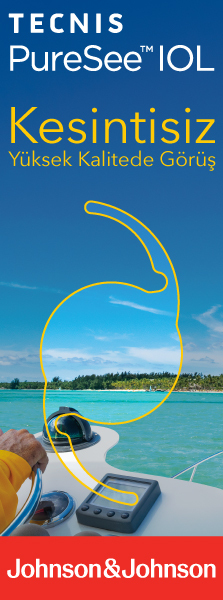2M.D. Professor, Ege University, Faculty of Medicine, Department of Ophthalmology, İzmir/TURKEY
3M.D., Düziçi State Hospital, Eye Clinic, Osmaniye/TURKEY Purpose: To compare the effects of accommodative, multifocal and monofocal intraocular lenses on subjective visual functions such as visual field, contrast sensitivity and glare after cataract removal.
Material and Methods: Patients who had been implanted accommodative, multifocal or monofocal intraocular lenses between 2010-2012 in our clinic were examined. Twenty one eyes which had been followed up at least 6 months included to this study. We compared the visual field, glare and contrast sensitivity of 7 eyes in each groups.
Results: The mean age of 11 (52%) male, 10 (48%) female patients was 60.3±13.5 years. The mean follow up time of 21 patients was 8.9±2.4 months. There were no differences between groups with respect to age, gender and best corrected distance visual acuity (p>0.05). There was a manifest trend to decrease in contrast sensitivity curve beginning from low spatial frequencies (1 cycle/degree) in multifocal group. Contrast sensitivity curve was mildly decreased to baseline of normal range beginning from medium-high spatial frequencies (2 and 3 cycle/degree) in accommodative and monofocal groups. Considering visual fields relative deficiencies in paracentral threshold values outside the central 10 degrees in multifocal group and near normal threshold values in accommodative and monofocal groups were attracted attention. Glare scores were 62% in multifocal, 79% in accommodative and 80% in monofocal groups respectively. There was no statistically significant relation between accommodative and monofocal groups for glare score but multifocal group has lower glare score than both accommodative and monofocal groups significantly (p<0.05).
Conclusion: Multifocal intraocular lenses are significantly worse than accommodative and monofocal intraocular lenses in terms of subjective visual functions such as visual field, contrast sensitivity and glare, but accommodative intraocular lenses have similar effects with monofocal intraocular lenses on these functions.
Keywords : Accommodative intraocular lens, multifocal intraocular lens, monofocal intraocular lens, visual functions




